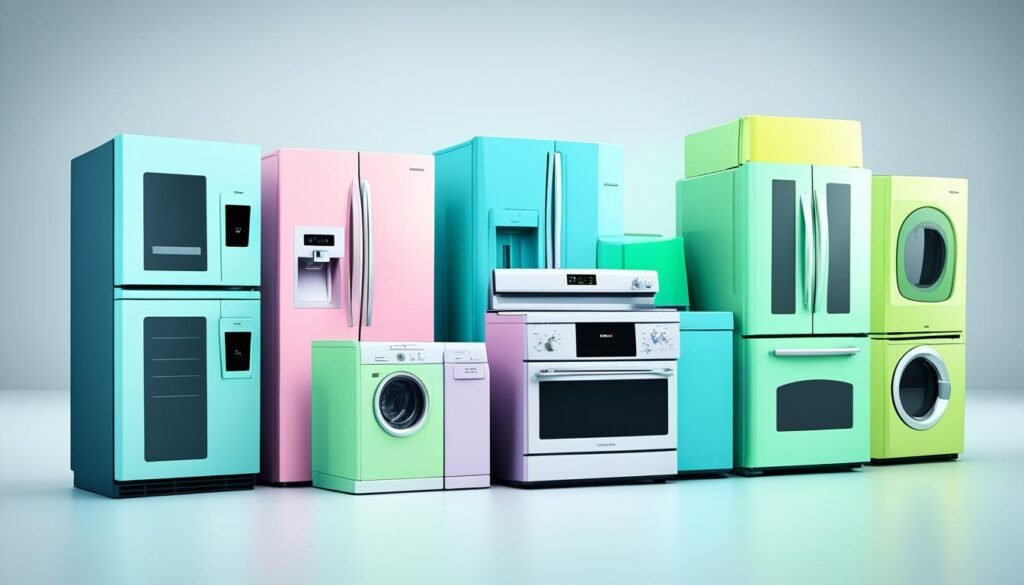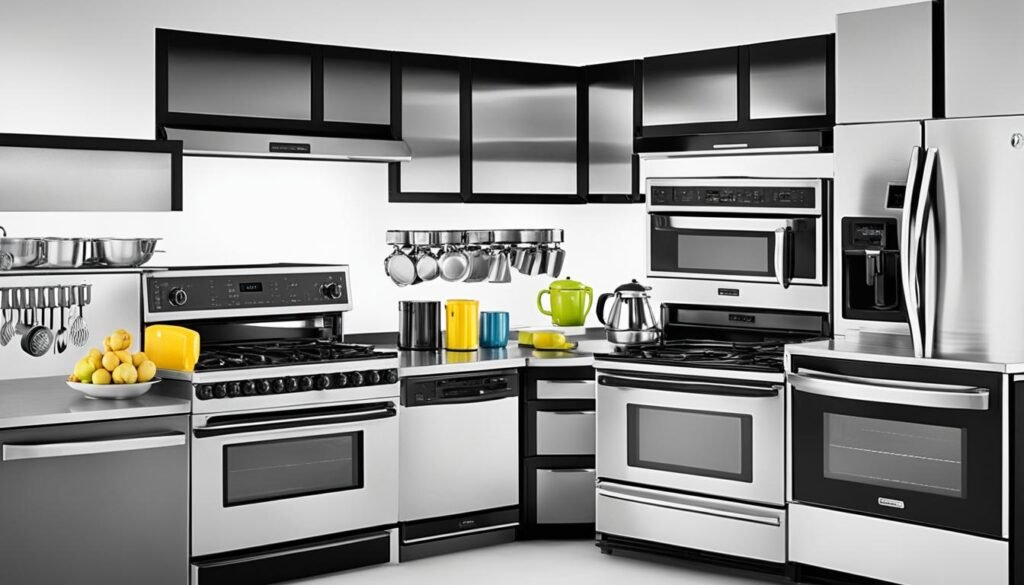In today’s world, the way we classify and group home appliances is very important. We have everything from fridges that save energy to thermostats that are smart. Knowing how to sort appliances helps a lot. This article looks at the different ways we classify home devices, like why we do it and what’s new in the field.
Technology is playing a bigger part in our homes every day. So, knowing how to sort and manage our devices is key. Whether it’s the kitchen or the laundry room, using systems that label smart devices right can make our lives easier and help us save money.
Key Takeaways
- It’s very important to know the various home appliance classification systems for many people, including homeowners and energy providers.
- Different groups based on what appliances do and how much energy they use can lead to better efficiency and savings.
- Making sure smart home systems and labels work together well is crucial for knowing and controlling our devices.
- Sorting fridges and air conditioners is vital because they often use a lot of home energy.
- The Dream Home Digest is a great guide for understanding home appliance classification’s complex world.
Introduction to Home Appliance Classification
In today’s fast-changing world, sorting home appliances is crucial. It makes Home Appliance Classification understandable. Appliance Categorization, Household Equipment Taxonomy, and Domestic Device Identification are key topics. So are Home Electronics Grouping and other ways to group devices.
Importance of Categorizing Household Devices
Categorizing home appliances helps in many ways. It guides shoppers through the many available choices. This way, they can pick what suits their needs best.
It also helps companies manage their products better. They can stock items efficiently, offering specific solutions to consumers.
Overview of Common Classification Approaches
There are different ways to group home appliances. You can group them by how they are used, like for cooking or cleaning. You could also look at how much energy they use. Or, you can see how they link to smart home systems.
These methods offer a good look at the home appliance world. It makes it easier for both shoppers and those in the industry to understand and choose wisely.
| Classification Approach | Examples |
|---|---|
| Purpose and Function | Kitchen Appliances (Refrigerators, Ovens, Dishwashers), Laundry Appliances (Washers, Dryers) |
| Energy Consumption | Low, Medium, and High Energy Usage Categories |
| Smart Home Integration | Appliance Identification for Automated Control |

Learning about these approaches helps everyone involved. It helps navigate the appliance world. This leads to a better user experience and more innovation in the industry.
Classifying by Appliance Purpose and Function
When organizing home appliances, it helps to group them by what they do. This way, homeowners can understand what each device offers. We will look at key types of kitchen and laundry appliances.
Kitchen Appliances
The kitchen is central to every home, and its appliances are key. Kitchen Appliance Sorting includes refrigerators, ovens, and dishwashers. For example, refrigerators keep your food fresh. Ovens help bake, roast, and cook many dishes. Dishwashers ease cleaning, saving time in the kitchen.
Laundry Appliances
Laundry Appliance Typing groups washers and dryers. Washing machines clean clothes, while dryers dry them. Knowing Washer Identification and Dryer Typing helps pick the right ones for your needs.
Organizing by purpose makes buying appliances easier. It covers Refrigerator Classification, Oven Categorization, Dishwasher Grouping, and more. This knowledge is key to a well-equipped home.

Home Appliance Classification
Exploring the endless options in home appliances can seem overwhelming. However, using a well-organized Household Equipment Taxonomy is key. It helps us efficiently identify and group Domestic Device Identification and Home Electronics Grouping. We’ll dive into different ways to sort household devices. We’ll see why having them organized is vital for managing our home technologies.
Home appliances often get sorted by what they do. This puts things like kitchen appliances (like refrigerators and ovens), laundry appliances (washers and dryers), and comfort appliances (such as air conditioners) into separate groups. This makes it easier for folks to find what they need for their homes.
Some like to classify appliances by how much energy they use. There are three main groups: low-energy, medium-energy, and high-energy. Breaking it down this way helps people choose items that are good for the planet and their wallet. It’s especially helpful for those interested in smart homes. Here, picking energy-efficient appliances is a key decision.
There’s also sorting by the kind of technology an appliance has. White goods for essential tasks, brown line for fun (like TVs), and gray line for work (including computers). Small appliances (such as blenders) show how tech is blending with items we use every day. This meets our changing needs.
Using a clear Household Equipment Taxonomy can make choosing home appliances much simpler. It aids in smart shopping and organizing our homes better. When we get the classifying methods, we can pick and organize our tech in a way that fits our lives perfectly.
“The key to effective home appliance management lies in a comprehensive understanding of the various classification systems and their underlying principles.”
Grouping Appliances by Energy Consumption
Understanding how much energy appliances use is key. We put them in categories like low, medium, or high energy users. This helps people pick the most energy-efficient options. Choosing wisely not only helps the planet but also lowers energy bills.
Low, Medium, and High Energy Usage Categories
Appliances are grouped into low, medium, or high energy use for a clearer view:
- Low Energy Usage: Think of small, energy-sipping gadgets like LED lights, smart thermostats, and laptops. They use under 500 watts most of the time.
- Medium Energy Usage: Here you’ll find fridges, washers, and dishwashers. Their power use falls between 500 and 2,000 watts.
- High Energy Usage: Big items such as ovens, dryers, and water heaters belong here. They can gobble up more than 2,000 watts.
Sorting appliances by energy use helps people figure out what to update for more efficiency. This makes their home’s energy use smarter and greener.
Also, using Smart Home Appliance Labeling and energy trackers offer insights. These tools show how appliances use energy. They help folks use less energy and save on their bills.
“Energy efficiency is crucial in reducing both energy consumption and emissions in the household sector.”
Smart Home Integration and Appliance Labeling
The residential sector uses a lot of energy, making it key to label home appliances well. In the U.S. almost 2.6 trillion kilowatt-hours were used at home in 2015. This number could jump by 13.5% by 2040. So, knowing what each device does and controlling them better is very important.
Appliance Identification for Automated Control
Installing smart home tech can change how we handle our gadgets at home. The key is making sure these systems know what each device is. Appliance Identification for Automated Control is crucial for a smooth and energy-wise home.
Users in smart homes might ignore system alerts and info more than half the time. This shows we need smarter ways to recognize our appliances. The K-Active-Neighbors (KAN) algorithm is one way. It uses machine learning to match device use with what each device does. This helps tweak alerts and info to grab the user’s attention better.
Smart home systems use sensors, Home Electronics Grouping, and Domestic Device Identification to really know our appliances. This way, they can track how much energy each device uses. Doing this helps set up better Smart Home Appliance Labeling and save power. This might cut energy use by 5% to 20%.
“Significant reductions in energy waste can be achieved through strategic power-saving practices and management, saving from 5% to 10%.”
The smart home industry is growing fast, asking for good ways to single out and control devices. New designs mixing machine learning and user needs promise big gains. They’ll make our energy use smarter, easier, and greener.
Conclusion
Throughout this article, we’ve seen how important it is to classify our home appliances. With the right grouping, you can make your home smarter and more energy-efficient. This means managing devices by what they do, how much energy they use, and what tech they work with.
We’ve covered various ways to group your appliances. This helps you understand and control what’s in your house better. It all leads to a smarter and more organized home.
As smart home technology keeps advancing, the need for good appliance organization grows. Keeping up with the latest in organizing your devices will make your home life better. It will bring more comfort, convenience, and save energy for the long run.
FAQ
What is the significance of effectively classifying home appliances?
Organizing home appliances well is key for a neater and more efficient home. It helps in controlling energy use, fitting in smart home items, and taking good care of these devices.
What are the common approaches to home appliance classification?
Home appliances are usually put into groups based on their main role. This includes sorting them by rooms like the kitchen and laundry room. They’re also classified by how much energy they use and if they work with smart home systems.
How are kitchen appliances and laundry appliances classified?
Kitchen items are sorted by what they do, like refrigerating food. This includes items such as ovens and dishwashers, each serving a specific kitchen function. On the other hand, laundry machines are grouped by their involvement in the washing and drying process.
What factors are considered when classifying home appliances?
The classification of appliances looks at several things. Not only their main role but also how much power they need, if they fit into a smart home environment, and their special features.
How do energy consumption patterns factor into home appliance classification?
Energy use is a big part of sorting appliances. They are usually put in groups of low, medium, or high energy needs. This helps users to control their power bills and be greener.
What role do smart home integration and appliance labeling play in home appliance classification?
Smart home tools and clear appliance labels make handling devices easier. They help in using energy smarter and add to the overall convenience of using the appliances.
Source Links
- https://www.mdpi.com/1996-1073/8/9/10522
- https://app.leg.wa.gov/wac/default.aspx?cite=296-17A-0607
- https://www.sciencedirect.com/science/article/abs/pii/S221067071830489X
- https://en.wikipedia.org/wiki/Home_appliance
- https://www.wcirb.com/products-and-services/classification-search/household-appliances
- https://www.vedantu.com/english/home-appliances-names
- https://www.inspec-bv.com/what-are-the-different-class-types-for-appliances-class-i-appliances-class-ii-appliances-class-iii-appliances
- https://en.wikipedia.org/wiki/Appliance_classes
- https://www.endesa.com/en/blogs/endesa-s-blog/home-appliances/how-are-appliances-classified
- https://www.edecoa.com/blog/common-household-appliances-classification-capacitive-inductive-resistive-load
- https://en.wikipedia.org/wiki/Major_appliance
- https://lifeyourway.net/types-of-household-appliances-and-their-advantages/
- https://media.nationalgeographic.org/assets/activity/assets/choosing-energy-efficient-appliances-1.pdf
- https://www.mdpi.com/1996-1073/16/2/824
- https://www.ncbi.nlm.nih.gov/pmc/articles/PMC9530195/
- https://dl.acm.org/doi/fullHtml/10.1145/3491241
- https://www.ncbi.nlm.nih.gov/pmc/articles/PMC11094021/
- https://link.springer.com/chapter/10.1007/978-3-031-63227-3_27
- https://www.ncbi.nlm.nih.gov/pmc/articles/PMC10867822/
- https://www.sciencedirect.com/science/article/abs/pii/S0378778822002584

